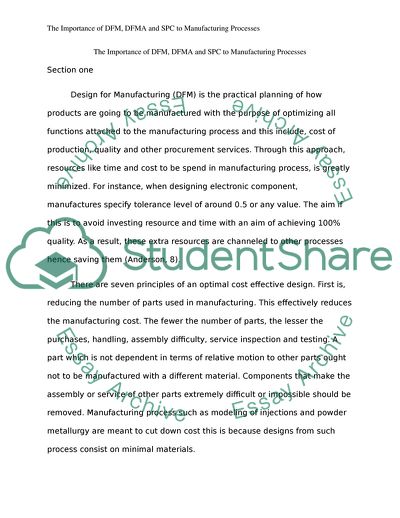Cite this document
(The Importance of DFM, DFMA and SPC to Manufacturing Processes Essay Example | Topics and Well Written Essays - 1750 words, n.d.)
The Importance of DFM, DFMA and SPC to Manufacturing Processes Essay Example | Topics and Well Written Essays - 1750 words. https://studentshare.org/design-technology/1855101-the-importance-of-design-for-manufacture-dfm-design-for-manufacture-and-assembly-dfma-and-statistical-process-control-spc-to-manufacturing-processes
The Importance of DFM, DFMA and SPC to Manufacturing Processes Essay Example | Topics and Well Written Essays - 1750 words. https://studentshare.org/design-technology/1855101-the-importance-of-design-for-manufacture-dfm-design-for-manufacture-and-assembly-dfma-and-statistical-process-control-spc-to-manufacturing-processes
(The Importance of DFM, DFMA and SPC to Manufacturing Processes Essay Example | Topics and Well Written Essays - 1750 Words)
The Importance of DFM, DFMA and SPC to Manufacturing Processes Essay Example | Topics and Well Written Essays - 1750 Words. https://studentshare.org/design-technology/1855101-the-importance-of-design-for-manufacture-dfm-design-for-manufacture-and-assembly-dfma-and-statistical-process-control-spc-to-manufacturing-processes.
The Importance of DFM, DFMA and SPC to Manufacturing Processes Essay Example | Topics and Well Written Essays - 1750 Words. https://studentshare.org/design-technology/1855101-the-importance-of-design-for-manufacture-dfm-design-for-manufacture-and-assembly-dfma-and-statistical-process-control-spc-to-manufacturing-processes.
“The Importance of DFM, DFMA and SPC to Manufacturing Processes Essay Example | Topics and Well Written Essays - 1750 Words”. https://studentshare.org/design-technology/1855101-the-importance-of-design-for-manufacture-dfm-design-for-manufacture-and-assembly-dfma-and-statistical-process-control-spc-to-manufacturing-processes.


